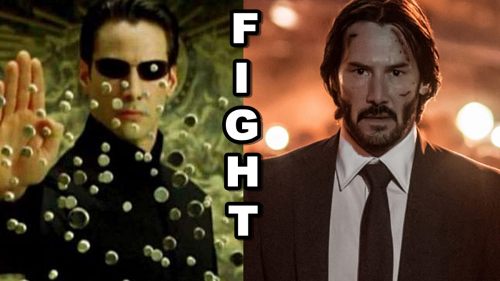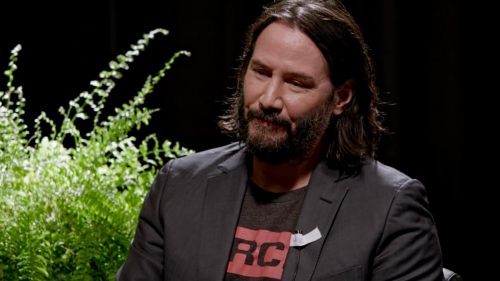JOHN WICK 3: PARABELLUM Review: Villainous Noggins Remain Totally Unsafe
Although Keanu Reeves has long been one of our enduring onscreen heroes, and audiences will probably never tire of wall-to-wall, expertly-choreographed action, the John Wick franchise has taken on a life that I’d wager even its creators never expected. Parabellum brings it to a tenuous close that highlights - and amplifies - the elements that make it such a scruffy charmer in a moviegoing landscape overstuffed with spectacle, while not quite sustaining the meteoric pace or trajectory the series has taken since it began in 2014. John Wick’s dyspeptic charm, lethal skill and indefatigable resourcefulness remain unvarnished in Reeves’ capable hands, but even under the watchful eye of the franchise’s chief shepherds, writer Derek Kolstad and director Chad Stahelski, this third installment aims to conclude the title character’s story with an ending that seems to get further away the more desperately he - and they - try to race towards it.
Picking up right where John Wick: Chapter 2 left off, Wick (Reeves) and his pit bull rescue race across town in the remaining minutes before the “head start” he was given by Continental manager Winston (Ian McShane) expires and the entire criminal underworld goes after the $14 million bounty on his head. Accumulating pursuers as the clock ticks down, Wick eventually has to fight his way across New York to visit the Director (Anjelica Huston), proprietor of a theatre for wayward boys and girls who reluctantly agrees to provide him safe passage to Casablanca. There, he reunites with Sofia (Halle Berry), a former colleague whose help he enlists to try and win an audience with the Elder (Said Taghmaoui) and make a plea to reverse his excommunication from the brotherhood of assassins.
Back in New York, the Adjudicator (Asia Kate Dillon) hires Zero (Mark Dacascos) and his school of assassin trainees to hunt down and execute John Wick, and then visits Winston and the Bowery King (Laurence Fishburne) to punish them for violating the rules of the High Table by helping John. But after John’s petition for clemency from the Elder comes at a tremendous cost - he must kill Winston and agree to live out his remaining days as a murderer for hire - he is forced to decide whether to live in servitude, or fight, and possibly die, holding onto the principles that not only liberated him from his profession but brought him into the graces of his late wife Helen (Bridget Moynahan).
The film opens with a gorgeous shot of the New York City skyline that cuts to another of the Statue of Liberty, and after watching John Wick fight in the first two films what seems like the city’s entire population, it came as a modest surprise that Libertas herself didn’t hop down from her pedestal and pick a fight with the hero. Truly, after three films, it feels like there’s just literally no one left in the world to challenge the character’s virtuosity, especially when director Chad Stahelski recruits longtime stuntman and Reeves’ personal instructor Tiger Chen, and perhaps more importantly, Indonesian martial arts legends Yayan Ruhian and Cecep Arif Rahman (both from The Raid 2) as henchmen eager to test their mettle against his peerless abilities.
Unfortunately, the inadvertent result of these shrewd casting choices is that these actors’ appearances, when you notice them in the cast, makes you want to watch some of the better movies in which they have appeared. As truly talented and committed as Reeves is in the role, either of the Indonesian actors alone would have mopped the floor with Wick, or at least in a film from their native country, it wouldn’t look quite so conspicuously like they were holding back. I mean, don’t get me wrong; there are truly only a handful of actors with the training and conditioning to perform the long feats of choreography that Reeves does in long takes throughout the entire film. But Stahelski, working from a script by Kolstad, Shay Hatten, Chris Collins and Marc Abrams, has created a problem in that each of Wick’s foes have to be tougher and more ruthless than the previous one, and it seems impossible to do that when he’s fought like a thousand of them.
That said, Stahelski’s addiction to cool imagery makes for some really interesting, if not always totally unique sequences; a climactic location built of reflective glass and floor-to-ceiling screens projecting undulating screensavers of grass and fire evokes the Shanghai skyscraper fight in Skyfall, for example, but the director’s focus on leveling up Wick’s adversaries transforms the influence into Bruce Lee’s Game of Death by way of TRON Legacy. There’s something almost Kubrickian about the handsomely appointed mahogany rooms in the Director’s theatre where tattooed ballerinas pirouette in one room and sweaty boys wrestle in the next. And even if the faceless, gun-toting bad guys literally get bussed in to take out Wick by the end of the film, they’re almost always bathed in some sort of cool ambient light that makes their choreographed flashlights flare like snake eyes in the darkness of whatever location John has chosen for his stronghold.
Though it’s uncertain whether or not there are further adventures for John Wick to have, or people for him to kill, Kolstad and his collaborators have created a phenomenal ensemble of actors to populate this stylish, intriguing criminal underworld, and the character’s mercy - or maybe just respect - for his toughest foes hints at the possibility that they will reunite and face off again one day. From Chapter 2, both Cassian (Common) and Ares (Ruby Rose) are possibly still alive, and Wick’s duels in this one come to knowing, victorious withdrawals from combat. Or maybe they’re all dead - in many cases, it’s impossible to tell where the line is between a really bad stabbing and a mortal wound, so who knows?
After three installments, the John Wick franchise has created this amazing, immersive foundation for its story, with so many fascinating little details that it’s easy to start imagining and speculating how it all works, what these specific characters’ roles are in its hierarchy, and what greater service in the world is needed to generate an elaborate network of murderers thousands upon thousands of people deep. (One imagines some of those questions will be answered in the rumored television show focused on the series’ hotel chain of choice, the Continental.) But at a certain point, the action ceases to be as dramatically compelling when the audience starts to feel like it’s driving the story instead of the other way around - and too often in Parabellum, that’s the case. It isn’t that the movie lacks energy or dramatic motivation; it’s that all of that stuff kinda grinds to a halt whenever John Wick has to fight one or two or ten more bad guys.
Of course, Reeves is so good in the title role, so wiry and limber, bruised and dignified, that it feels like he can go on fighting as long as there are people for him to fight against. And certainly there are worse choices for audiences than to get to watch more John Wick movies. But if Parabellum - which means “to prepare for war” - leads to yet another installment, or if it’s possible, an even bigger battle, let’s hope these gifted filmmakers give the character a reason to fight. Because they’ve spent three movies showing us that he’s exceptionally good at it, but really, really wants to stop - and as enjoyable as all of it is to watch, he’s almost convinced us to let him.



